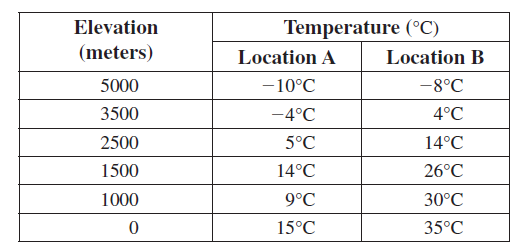All of the following is true in regard to the earth's radiation balance except
A) at around 35°, incoming insolation is roughly balanced with outgoing longwave radiation.
B) poleward of 35° regions emit more outgoing longwave radiation than they receive as insolation.
C) outgoing longwave radiation increases poleward in regular increments, peaking at the poles.
D) equator, tropics, and subtropics receive more insolation than what they emit as outgoing longwave radiation.
C) outgoing longwave radiation increases poleward in regular increments, peaking at the poles.
You might also like to view...
Daisy's average speed when running a distance of 2 km in one-half hour is
A. 1 km/h. B. more than 4 km/h. C. 2 km/h. D. 4 km/h.
On the following chart, use the sets of hypothetical data to plot the vertical temperature profile (the environmental lapse rate) of the atmosphere in two locations. Using a straightedge, connect the temperature points for Location A with a blue line, and for Location B with a green line (if you do not use colored lines, label each line clearly). After completing the temperature profiles, answer the questions on the following page.

Which statement about iron oxidation is false?
A) Oxidation of iron helps to protect rocks against weathering. B) Limonite is an iron hydroxide mineral. C) Hematite is the most common red iron oxide mineral. D) Iron is one of the most abundant minerals in Earth's crust, and iron oxidation is a common reaction in chemical weathering on Earth.
In a greenhouse, a plant would be best positioned so that its exposure to sunlight would be
A) within its limits of tolerance. B) within its optimal range. C) at its zones of stress. D) at the photosynthetic limit.